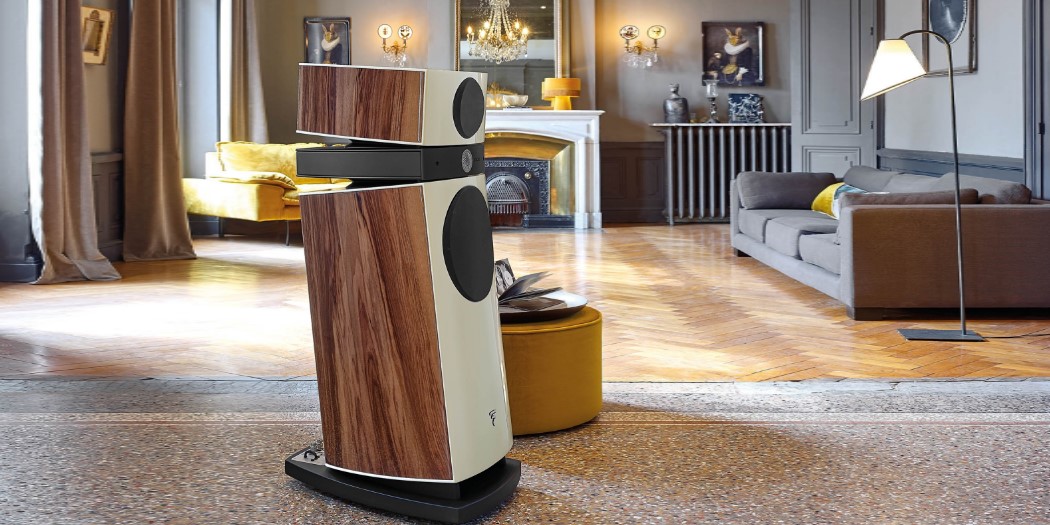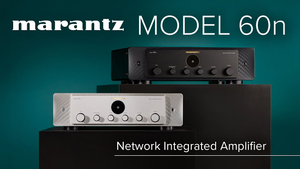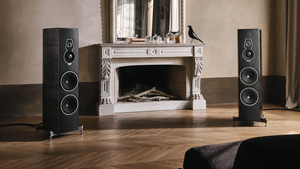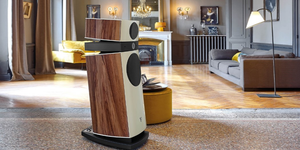
Focal Scala Utopia Evo Review: The Sound of Evolution
Introduction: An Evolution in Utopia
There are moments in an audiophile’s journey that are marked by a palpable sense of occasion. The arrival of a component from a manufacturer’s flagship range is one such moment. When the Focal Scala Utopia Evo loudspeakers arrive, they do so not with subtlety but with a statement of intent. Even in their substantial wooden crates, their presence is formidable, hinting at the serious engineering and acoustic ambition contained within. At 187.4 lbs (85 kg) each, these are not speakers one casually positions; they demand respect, effort, and a commitment to extracting their potential.
The Scala Utopia Evo is the most accessible floorstanding loudspeaker in Focal’s revered Utopia III Evo line, a family of transducers that culminates in the colossal, cost-no-object Grande Utopia EM Evo. To call the Scala the "entry point," however, would be a profound mischaracterization. It is, unequivocally, a Utopia, designed to deliver the core essence of Focal's flagship philosophy in a form factor more amenable to a wider range of listening environments. Its mandate is to be a more "moderately sized" reference, but a reference nonetheless.

The key to its identity lies in its suffix: "Evo." This is not a mere marketing flourish denoting a minor refresh. It signifies a deep and meaningful evolution, the culmination of nearly a decade of research and development since the Utopia III line was first unveiled in 2008. The mission was to preserve the "undisputed musicality" and celebrated sound architecture of its predecessor while integrating the company's most significant technological breakthroughs to push the boundaries of clarity and precision even further.
Interestingly, the path of this evolution subverts the industry's traditional technological hierarchy. The two most critical innovations that define the Evo series—the Tuned Mass Damper (TMD) suspension and the Neutral Inductance Circuit (NIC)—were first developed and proven in the less expensive, yet highly ambitious, Sopra line. In a fascinating reversal of the typical "trickle-down" model, where flagship technologies gradually find their way into more affordable products, Focal has implemented a "trickle-up" revolution. This suggests a dynamic and non-hierarchical approach to innovation, where a successful research platform, regardless of its market position, can inform and refine the very pinnacle of the company's offerings. The Scala Utopia Evo is, therefore, more than just an improved Scala; it is the embodiment of Focal's most current acoustic thinking, a synthesis of lessons learned from across its entire high-end portfolio. It stands as a testament to a relentless, iterative pursuit of sonic truth.

Form Follows Function: An Acoustic Sculpture
The visual identity of the Utopia line has always been as distinctive as its sound, and the Scala Evo is no exception. Its form is a direct expression of its acoustic function, a principle most evident in its segmented, "accordion-like" silhouette. This is the physical manifestation of Focal's "Focus Time" architecture, a design that mechanically time-aligns the acoustic centers of the drivers. Each of the three drivers—tweeter, midrange, and woofer—is housed in its own separate, acoustically optimized sub-enclosure. These modules are then precisely angled to ensure that the sound from each driver arrives at the listener's ears simultaneously, creating a coherent and phase-accurate wavefront. It is a complex, physical solution to a fundamental challenge in multi-way loudspeaker design, executed with sculptural grace.
The foundation of this structure is the cabinet itself, what Focal terms the "Gamma Structure". The objective is to create a supremely inert platform for the drivers, one that does not vibrate or resonate, thereby preventing the cabinet from becoming a secondary, unwanted source of sound that can blur the final image. To achieve this, Focal employs panels of high-density MDF up to an immense 2 3/8 inches (6 cm) thick, heavily braced and optimized using vibration cartography to identify and eliminate any structural weak points.
In a market segment where exotic composites and machined aluminum are often touted as prerequisites for performance, Focal’s steadfast commitment to MDF is a telling philosophical choice. The company argues that MDF, when properly engineered, possesses an ideal combination of stability, mass, and internal damping, making it the optimal material for an acoustically dead enclosure. This reflects a design ethos rooted in engineering pragmatism and material honesty. The value and performance are derived not from the raw material itself, but from the masterful execution and craftsmanship applied to it.
That craftsmanship is on full display in the speaker's finish. Each cabinet is handcrafted in Focal's dedicated Ebénisterie Bourgogne workshop in France, a facility staffed by master cabinet-makers. The available finishes are of a quality usually reserved for luxury automobiles and bespoke furniture, from flawless multi-layer lacquers in colors like Metallic Blue and Ash Grey to premium Noyer Naturel (Natural Walnut) and Noyer Foncé (Dark Walnut) veneers sourced from hundred-year-old trees. The result is a loudspeaker that transcends its function as an audio component to become a true piece of industrial art, a "visual aesthetic statement" designed to be as beautiful to behold as it is to hear.

The Science of Sound: A Deep Dive into Focal's Innovations
At the core of any Focal loudspeaker lies a suite of proprietary driver technologies developed and manufactured entirely in-house in Saint-Étienne, France. The Scala Utopia Evo represents a concentration of the company's most advanced research, a showcase of the science that underpins its sonic signature.
The Beryllium Heart
For over two decades, Focal's use of pure Beryllium for its tweeter domes has been a defining characteristic of its high-end speakers. The 1 1/16-inch (27 mm) inverted dome tweeter in the Scala is a prime example. Beryllium possesses a unique combination of extreme rigidity and low mass, a holy grail for high-frequency transducer design. This allows the diaphragm to move with incredible speed and precision without deforming, enabling an exceptionally wide frequency response that extends from 1 kHz to a super-sonic 40 kHz. This vast bandwidth ensures the faithful reproduction of not just primary tones but also the delicate upper harmonics and micro-details that create a sense of air and realism. The tweeter is housed within a design Focal calls IAL2 (Infinite Acoustic Loading), which uses a damped rear chamber to absorb the tweeter's back wave. This lowers the fundamental resonance frequency to just 528 Hz, nearly two full octaves below the 2,400 Hz crossover point, ensuring that the tweeter operates in a region free from resonant interference, resulting in breathtaking purity and transparency.

The 'W' Cone Engine
The midrange and woofer drivers employ Focal's third-generation 'W' composite sandwich cone. This proprietary material is constructed by layering two sheets of ultra-fine woven glass fibre over a structural foam core. This "sandwich" construction allows Focal's engineers to precisely control the three critical parameters of a driver cone: lightness for rapid acceleration and transient response; rigidity to resist deformation under stress and prevent distortion; and damping to eliminate unwanted resonances within the cone material itself. By optimizing the thickness of the foam core and the number of glass fibre layers for each specific driver, Focal can tune the cone's behavior for its intended frequency range. This technology is fundamental to the clarity, neutrality, and low-distortion performance that characterizes the entire Utopia line.

The Midrange Revolution (TMD & NIC)
The most significant advancements in the "Evo" series are concentrated in the 6.5-inch midrange driver, a frequency band that is absolutely crucial for the realistic reproduction of voices and most instruments.
First is the TMD (Tuned Mass Damper) suspension. Drawing inspiration from principles used to stabilize skyscrapers during earthquakes, this technology adds two small, precisely weighted tubular rings to the driver's surround. These rings act as harmonic dampers, counteracting the natural resonance of the surround and stabilizing its movement, particularly in the critical 1 kHz to 4 kHz range where the surround can behave erratically. By controlling these deformations, the TMD suspension dramatically reduces distortion and produces a more linear frequency response, resulting in the "remarkable neutrality" that is the hallmark of the Evo midrange.
The second innovation is the NIC (Neutral Inductance Circuit). The magnetic field in a conventional driver motor can fluctuate with the position of the voice coil and the frequency of the audio signal, leading to harmonic and intermodulation distortion. The NIC technology introduces a sophisticated Faraday ring into the magnetic circuit, meticulously optimized in its dimensions, material, and position to stabilize the magnetic flux. This creates an "incredibly stable magnetic circuit" that is unaffected by the driver's operation, resulting in a sound that is more precise, better defined, and free from artifacts.
The Power Plant
Driving the midrange 'W' cone is Focal's unique Power Flower™ magnet structure. Rather than using a single, large ferrite magnet, the Power Flower design employs a stack of several smaller ferrite rings arranged in a floral pattern around the central voice coil. This configuration concentrates the magnetic energy in the gap, providing a powerful and consistent force for tenfold power handling. Crucially, the spaces between the magnet "petals" create open channels, allowing hot air to freely circulate away from the voice coil. This exceptional ventilation prevents thermal compression—a phenomenon where a driver's performance degrades as the voice coil heats up during prolonged high-power use—ensuring dynamic consistency and reducing distortion linked to mechanical compression.
The Listening Room: Setup and Synergy
Living with a loudspeaker of the Scala Utopia Evo's caliber is an exercise in optimization. While their design is more accommodating than that of their larger siblings, extracting their full measure of performance requires careful attention to setup and system matching. The initial uncrating and placement, though demanding, is made considerably easier by the low-profile casters integrated into the speaker's plinth, a thoughtful touch that allows for easier experimentation with positioning before the final spiking.
And experimentation is key. Reviewers and owners alike report that the Scalas are highly sensitive to their position in the room. "Microscopic shifts in fore and aft location, precise adjustment of listening distance, toe-in and height" are not obsessive tweaks but necessary steps to lock in the holographic soundstage and tonal balance of which they are capable. Placed too close to walls, their potent bass can overwhelm a room; placed too far apart, the central image can lose focus. When positioned correctly, however, they achieve a truly massive and coherent soundstage. It is also worth noting that their prodigious low-frequency output, which extends down to 24 Hz (-6dB), can excite room modes, particularly around 35 Hz, making a well-treated listening space or the judicious use of digital room correction a significant asset.
The Scala's relationship with amplification is similarly nuanced. With a high sensitivity of 92 dB, they do not require immense power to achieve high volume levels. However, this figure can be misleading. To properly control the large 11-inch woofer and reveal the full dynamic and textural capabilities of the drivers, they thrive on high-quality, high-current amplification. The close corporate relationship between Focal and Naim Audio is not merely a marketing convenience; numerous users report a special synergy, noting that the speakers truly "come alive" when paired with Naim electronics, from the 300DR to the flagship Statement amplifiers. Yet, the Scalas are not a one-trick pony. Their transparency allows them to pair beautifully with a wide range of electronics, from the rich, powerful warmth of McIntosh and Gryphon amplifiers to the detailed control of Pass Labs. One owner did find that a neutral-to-dry T+A integrated amplifier was perhaps not an ideal match, suggesting the Focals benefit from electronics with a touch of warmth and body.
The Evo model significantly enhances this flexibility by introducing bi-amplification capabilities via a double terminal board. This allows the most discerning users to power the bass and mid/treble sections with separate amplifiers, enabling a level of system tuning previously reserved for the larger Utopia models. Further refinement is possible via the OPC+ (Optimum Phase Crossover) filtering, which provides jumpers on the rear panel to subtly adjust the bass and treble levels by ±1dB, helping to better integrate the speaker's response with the room's unique acoustic signature.
Ultimately, the experience of setting up and living with the Scala Utopia Evo reveals a deeper truth about their nature. Because of their extremely high resolution and vanishingly low distortion, they act less as a simple transducer and more as a high-precision diagnostic tool for the entire audio chain. They do not flatter or editorialize; they reveal. If the bass is boomy, it is likely a room interaction. If the treble is harsh, the fault may lie with the source or amplification. This explains the sometimes-conflicting reports from audio shows versus dedicated listening rooms; the speaker's performance is a direct reflection of the quality of the system and environment in which it is placed. To purchase the Scala Utopia Evo is not to acquire an endpoint, but to embark on a journey of system optimization, where the speaker itself is the unerring guide.

The Performance: Music Made Manifest
Once properly situated and partnered, the Focal Scala Utopia Evo ceases to be a collection of advanced technologies and exquisite materials. It becomes a conduit for music, performing a vanishing act that is the aspiration of all great loudspeaker designs. The physical cabinets, for all their sculptural beauty, seem to dissolve, leaving behind a soundstage of breathtaking scale and dimensionality.
The soundstage is consistently described as "holographic," extending far beyond the physical boundaries of the speakers in width, depth, and height. Within this vast acoustic space, images are rendered with unwavering stability and pinpoint precision. On well-recorded orchestral pieces, one can not only place the various sections of the orchestra but also perceive the air between the musicians. This is the "huge soundstage" and "disappearing aspect" that owners and reviewers celebrate, a quality that transforms listening from a two-dimensional presentation into a three-dimensional, immersive experience.

The true magic, however, resides in the midrange. This is where the TMD and NIC technologies make their most profound impact. Vocals are rendered with a "lifelike" presence and an unnerving sense of realism; one can hear the subtlest inflections, the texture of the voice, and the delicate sound of the artist taking a breath. There is a complete absence of the grain, hardness, or "electronic twang" that can afflict lesser designs. Instead, there is a "remarkable neutrality" and purity that allows the emotional content of the performance to communicate directly and without impediment. Acoustic instruments like piano and guitar are reproduced with their full harmonic structure intact, their timbre natural and uncolored. This is the "magical midrange" that forms the emotional core of the Scala's performance.
This midrange purity is underpinned by a foundation of deep, articulate, and powerful bass. The 11-inch 'W' woofer delivers low frequencies with a combination of speed, control, and authority that is deeply satisfying. The bass is consistently described as "tight," "precise," and "articulate," capable of delineating complex bass lines and delivering the visceral impact of a kick drum without any trace of mud, bloat, or overhang. This control extends to the speaker's dynamic capabilities. The Scala handles large-scale dynamic swings with effortless ease, reproducing the full force of a symphony orchestra or the slam of a rock band without compression or strain. Yet, it is equally adept at the other end of the dynamic spectrum, resolving the most subtle micro-dynamic shifts and nuances that bring a performance to life.
Tying this all together is a seamless coherence across the entire frequency spectrum. The crossover points are utterly imperceptible; the Beryllium tweeter, 'W' midrange, and 'W' woofer speak with a single, unified voice. The tweeter provides "crystal" clear highs that are extended and airy but never strident, integrating perfectly with the midrange below it. The result is a presentation of stunning transparency and fidelity to the source. The Scala Utopia Evo does not just play music; it reconstructs the original musical event in the listening room with a level of realism and emotional immediacy that is, in a word, profound.

The Competitive Landscape: Context and Comparisons
To fully appreciate the achievements of the Scala Utopia Evo, it is essential to place it within the context of its peers. In the fiercely competitive world of high-end audio, different designers pursue sonic truth via different philosophical paths, resulting in products with distinct sonic personalities.
Versus Focal Sopra
The most logical first comparison is within Focal's own family, against the highly regarded Sopra line. While the Sopra N°3 shares some of the Scala's dynamic verve, the Utopia presents everything on a grander scale: the soundstage is larger, the bass digs deeper, and the sense of authority is greater. The most crucial distinction, however, lies in timbral purity and resolution. In direct side-by-side comparisons with the larger Maestro Utopia, reviewers have noted that the Sopra can exhibit an "almost electronic twang" and a degree of muddiness in the bass relative to the Utopia's "much more natural timbre" and "incredibly tight" low-frequency control. The consensus is clear: while the Sopra is a formidable loudspeaker in its own right, the Utopia represents a significant and undeniable leap into a higher echelon of performance. They are, as one user put it, simply "not comparable".
Versus Wilson Audio Sasha DAW
A comparison with the Wilson Audio Sasha DAW highlights a fascinating divergence in design philosophy. Wilson Audio has long been a proponent of using proprietary, ultra-dense composite materials for its cabinets—like their "X-Material" and "S-Material"—and providing for meticulous time-alignment through physical adjustment of the upper "head" unit. Focal, by contrast, focuses on perfecting the drivers themselves (Beryllium, 'W' cone, TMD, NIC) and houses them in a fixed "Focus Time" architecture built from what they argue is optimally engineered MDF. This can be viewed as a contrast between a cabinet-centric and a driver-centric approach to loudspeaker design. Anecdotal comparisons from users who have owned both (or their larger siblings) suggest the Focals offer a presentation that is more detailed, more texturally rich, and more holographically imaged, with bass that is exceptionally tight and articulate. The choice may come down to a preference for Wilson's characteristic weight and harmonic expression versus Focal's emphasis on speed, transparency, and micro-detail.
Versus Magico S3 Mk III
The Magico S3 Mk III represents yet another path to neutrality. Magico is renowned for its use of sealed (acoustic suspension) enclosures CNC-machined from solid aluminum, a design that yields exceptionally articulate, defined, and linear bass, free from any port-related colorations. The Scala, being a ported design, is inherently more efficient and capable of greater low-frequency extension from a given cabinet volume. Sonically, Magico speakers are often lauded as the epitome of analytical purity and possessing an incredibly low noise floor, earning them the moniker of the "vanishing speaker". The Focal sound, while also exceptionally neutral, is frequently described as more energetic, ebullient, and dynamically expressive—perhaps a more "raw" and emotionally immediate presentation. The decision between these two titans could be framed as a choice between the absolute, unflinching neutrality and timbral purity of the Magico versus the dynamic vibrancy and palpable energy of the Focal.

Conclusion: The Attainable Summit
In the rarified air of high-end audio, a true statement product must do more than simply sound good; it must embody a clear and compelling vision of what music reproduction can be. The Focal Scala Utopia Evo is unequivocally such a product. It is a masterful synthesis of cutting-edge acoustic science, meticulous craftsmanship, and profound musicality.
The "Evo" evolution is a resounding success. The integration of the TMD suspension and NIC motor has elevated an already exceptional midrange to a level of neutrality, purity, and emotional immediacy that is simply breathtaking. This, combined with the crystalline extension of the Beryllium tweeter and the deep, articulate power of the 'W' woofer, creates a sound that is seamlessly coherent, dynamically explosive, and utterly transparent to the source. The speaker's ability to cast a vast, holographic soundstage and then disappear within it is a feat of engineering that must be heard to be fully appreciated.
While it is the most accessible floorstander in the Utopia line, there are no compromises here. The Scala Utopia Evo delivers a massive slice of the performance offered by its larger, astronomically priced siblings, but in a package that is more likely to integrate successfully into the real-world listening spaces of dedicated audiophiles. It is a demanding partner, to be sure, requiring careful setup and high-quality ancillary equipment to unlock its full potential. But as a high-resolution tool, it is an honest one, faithfully revealing the character of the entire system and guiding its owner on a rewarding journey of optimization.
Ultimately, the Focal Scala Utopia Evo stands as a new benchmark. It is a speaker that can satisfy both the analytical mind and the music-lover's heart. It possesses the technical prowess to resolve the finest details in a recording and the dynamic authority to convey the full power of a performance, but its greatest strength is its ability to get out of the way, to serve as a clear window onto the original artistic event. For the discerning listener seeking a profound and lasting connection to their music collection, the Scala Utopia Evo is not just a loudspeaker; it is a destination. It is, as one reviewer who considered replacing his long-term reference speakers for them attested, truly that good.

Specifications
| Specification | Value |
| Type | 3-way bass-reflex floorstanding loudspeaker |
| Drivers | Woofer: 11" (27cm) 'W' composite sandwich cone Midrange: 6.5" (16.5cm) 'W' composite sandwich cone with TMD suspension and NIC motor, Power Flower™ magnet Tweeter: 1 1/16" (27mm) IAL2 pure Beryllium inverted dome |
| Frequency Response (±3dB) | 27Hz – 40kHz |
| Low Frequency Point (-6dB) | 24Hz |
| Sensitivity (2.83V/1m) | 92dB |
| Nominal Impedance | 8 Ω |
| Minimum Impedance | 3.2 Ω |
| Crossover Frequencies | 220Hz / 2,400Hz |
| Recommended Amplifier Power | 50 – 500W |
| Dimensions (HxWxD) | 49.09" x 15.47" x 26.37" (1247 x 393 x 670mm) |
| Net Weight | 187.4 lbs (85kg) |
| Finishes | Black Lacquer, Carrara White, Ash Grey, Hot Chocolate, Noyer Naturel (Natural Walnut), Noyer Foncé (Dark Walnut), Custom Automotive Colors on request |
| Country of Origin | France |






Comments